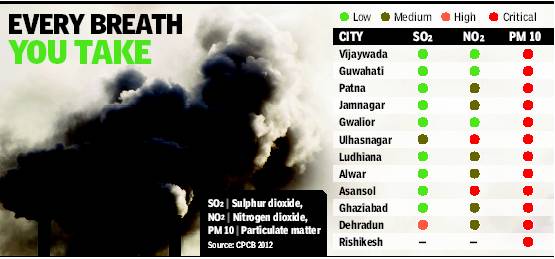Cities of India: issues
This is a collection of newspaper articles selected for the excellence of their content. |
Contents |
Indian cities: Environmental issues
Cities turn into concrete ovens Jayashree Nandi | TNN 2013/06/05 The Times of India
Surat
Cities are creaking under their own weight. And heat. In Surat, for instance, parts of the city with dense concrete jungles swelter at temperatures 5 degrees higher than the city’s greener parts. This phenomenon, of parts of a city having higher temperature than the remaining areas, is called an ‘urban heat island’ (UHI) and till recently was associated with big metros. But the phenomenon has now spread to India’s smaller cities and towns.
Coimbatore
In the lush Western Ghats, parts of Coimbatore today are comparable to any concrete city in China, says Kiran Rajashekariah, a World Wide Fund for Nature (WWF) researcher. Between 2004 and 2010, urban sprawl has doubled, so has the built-up area. The region’s elephant corridors are choked by real estate projects, elephants frequently killed in accidents on roads and rail tracks. The city also has a satellite town coming up, an Indo-Dubai residential venture spread over 1,200 acres, built in the middle of an elephant corridor.
Gangtok
Cool, breezy Gangtok is today neither cool, nor breezy. Hotelier Karma Tenpa says he takes half an hour to cover the one-kilometre distance from his home to MG Marg. “I’d rather walk” says Tenpa, fed up with traffic jams, a common occurrence with a rapid increase in cars. There is barely space to park in the hilly terrain.
Tier II cities
India’s tier II cities are transforming at a monstrous pace — UHI, traffic congestion, air and water pollution becoming urgent environmental concerns. In every part of the country, unplanned, rapid and rampant urbanisation is pushing these smaller cities to a sick state.
None more so than industrial sub-cities Narela and Bawana are close to burning. “These areas show a temperature difference of 10 to 15 degrees,” says Teri researcher, Richa Sharma who documented Surat’s UHI phenomenon. With several UHI pockets, the city’s cooling demands have shot up, feeding into a vicious cycle of air-conditioning creating more heat.
Vehicular pollution
Vehicular pollution is also wreaking havoc. Chandigarh, a class III city population-wise, has a motorization rate higher than mega cities, says a Centre for Science and Environment report. Between 2010 and 2011, number of vehicles increased by 38 % in contrast to 9% in Bangalore, 15% in Delhi. Chandigarh has 227 cars per 1,000 people, Delhi 117 per 1,000. Kanpur with way fewer vehicles than Delhi, has a congestion index close to the capital’s. “Bhiwadi, near Jaipur is promoted by government and developers as India’s third-largest industrial hub. It has township projects, IT hubs; all sorts of industry. The volume of effluents generated is far greater than the treatment capacity. Majority of effluent flows into low-lying areas,” says Anumita Roychowdhury, CSE.
Gurgaon and Ghaziabad are prime examples of the unplanned boom. Gurgaon resident Sugandh Sinha recollects how her apartment did not have full power backup. So, in the long outages that could stretch to over eight hours, residents used diesel gen-sets.
RIVERS GOING BUST
Dead water bodies in parched cities are another ogre. Gujarat’s glorified growth story comes a cropper in the face of the toxic levels in its industrial clusters and river bodies that have touched new highs. Amlakhadi in Ankleshwar or Damanganga River in Vapi figured right up there in a ranking of South Asia’s most polluted sites.
River Noyyal, once a source of drinking water for Coimbatore is a “cesspool” now and farmers consider it a “curse” because it pollutes their fields every year. Dye discharge from dyeing industries have killed Noyyal, adds WWF’s Kiran.
Mula-Mutha | Pune
Musi | Hyderabad
Khan | Indore
Sabarmati | Ahmedabad
Vishwamitri | Vadodara
Noyyal | Coimbatore
Karamana | Thiruvananthapuram
Cooum | Chennai
Gomati | Lucknow
The UN Framework Convention on Climate Change
Nitin Sethi 2013/06/05
Negotiations under the UN Framework Convention on Climate Change never hinged on what science told nations, nor did leaders react as urgently as science urged them to. Had that been so, the 2009 Copenhagen meeting on the back of a calamitous IPCC report would’ve got the US to agree to urgent emission cuts. It would’ve forced EU to do more and forced China, Brazil, India and South Africa to greater responsibility.

